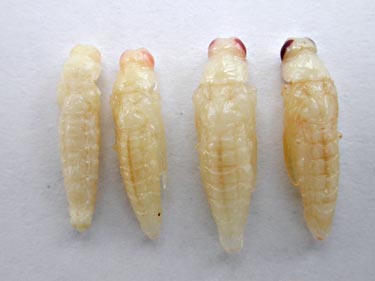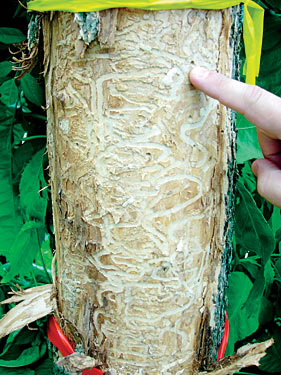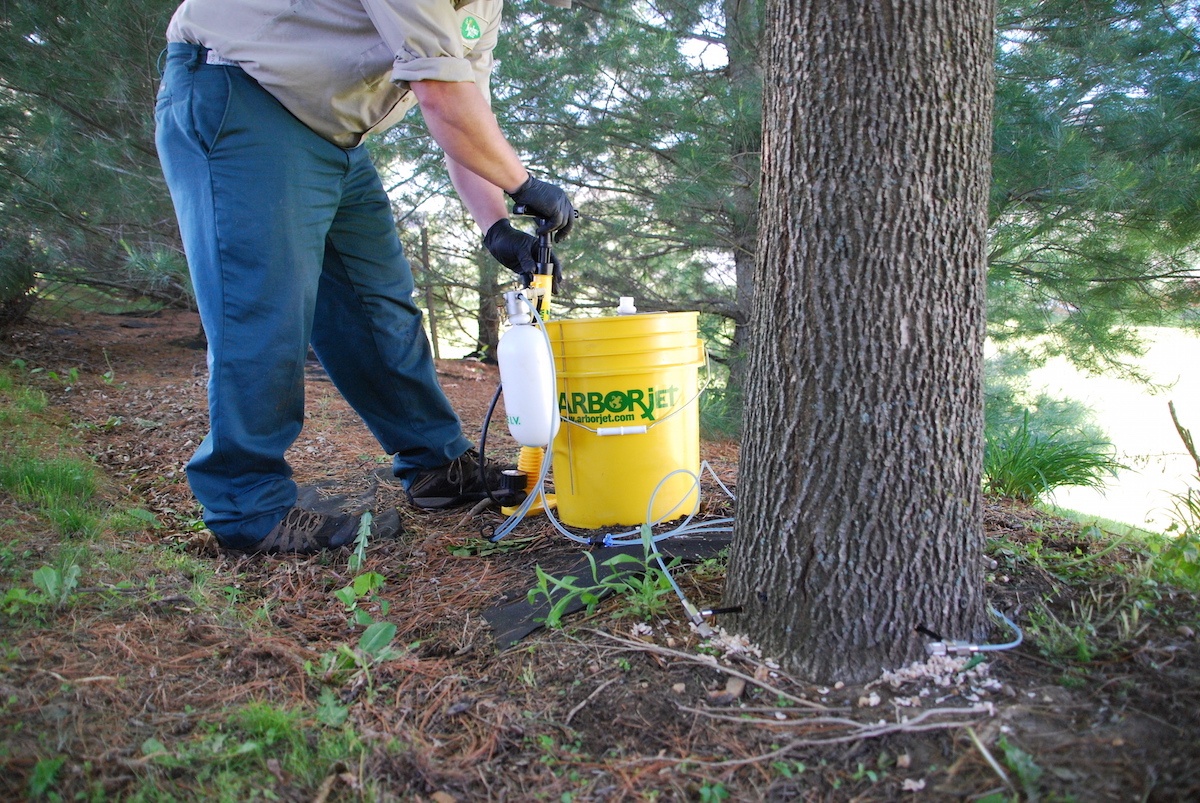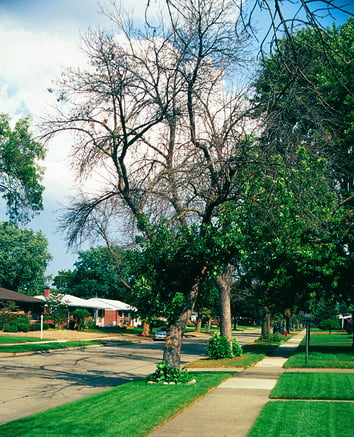Since it was first detected in Detroit in 2002, the Emerald Ash Borer pest has been systematically destroying ash trees everywhere it travels.
If you haven’t already heard of the Emerald Ash Borer (EAB), you will. According to a forestry management plan put together by the Pennsylvania Department of Conservation and Natural Resources, the EAB is the “most destructive exotic forest pest in North America” with the ability to “destroy the entire ash genus.” It’s disturbing just how quickly the pest can wipe out these trees.
The EAB is something that we’ve been talking about for a long time. As Certified Arborists offering tree care services in Allentown, Bethlehem, and Easton, PA, it is our job to stay ahead of these threats and we’ve been following it ever since it emerged. While it’s certainly not a new issue, we recognize that this may be new information to many in our region and wanted to put together some helpful Emerald Ash Borer facts. Our hope is to continue to educate folks in our area so that we can preserve as many of the ash trees as possible. This is important information if you have an ash tree on your property.
Emerald Ash Borer Facts
The Emerald Ash Borer is an exotic beetle that was first discovered in the Detroit area in the summer of 2002. It’s believed to have been brought to the United States on wood packing material on cargo ships or airplanes originating from Asia.

While the EAB is not considered a highly destructive pest in its native habitat of Asia, in North America it is considered one of the most destructive pests around today. Since arriving in this part of the world, this pest has destroyed hundreds of millions of ash trees in North America.
Here are some additional Emerald Ash Borer facts you should know about this pest in its adult form:
- Adults are dark green, shiny and ½” to 1” in length.
- They feed on ash foliage and live for about a month.
- They fly from early May until September. Their peak is July.
- Females typically lay 60 to 90 eggs.
Of course, EAB beetles begin their lives as larvae. Here are some facts about their larvae.
- The EAB begins as creamy white, legless larvae with flattened, bell-shaped body segments.
- Larvae feed beneath the bark making S-shaped galleries for the rest of the year.
- When they emerge as adults, they leave a D-shaped hole.
Emerald Ash Borer Damage
 Here in the Lehigh Valley, we have a lot of insects that feed on ash trees. You may think you have Emerald Ash Borer damage when in fact it is something else. One notable sign that it is, in fact, EAB feeding on an ash tree is the D-shaped hole that these pests leave as they exit the bark as an adult. In addition, due to the fact that woodpeckers like to feed on their larvae, noticing heavy woodpecker damage on an ash tree is another possible sign of infestation, as well as die-back at the top of the tree.
Here in the Lehigh Valley, we have a lot of insects that feed on ash trees. You may think you have Emerald Ash Borer damage when in fact it is something else. One notable sign that it is, in fact, EAB feeding on an ash tree is the D-shaped hole that these pests leave as they exit the bark as an adult. In addition, due to the fact that woodpeckers like to feed on their larvae, noticing heavy woodpecker damage on an ash tree is another possible sign of infestation, as well as die-back at the top of the tree.
Surprising to many is the fact that it is not the adult, flying beetle that is the serious concern. Adult EAB beetles chew on ash foliage but don’t cause a lot of damage. As mentioned, it’s actually the beetle’s larvae that cause the damage. Female beetles lay eggs in the bark of ash trees and the emerging larvae then feed on the live tissue behind the bark, disrupting the tree’s ability to function by preventing it from circulating water and nutrients.
While adults have a short lifespan, it can be as many as one to two years until the adults emerge from the larval stage. That means these pests could feed for quite some time on your ash tree, doing a tremendous amount of damage.
Here is a summary of EAB damage that you may notice on ash trees in our region:
- Dieback from the top down
- Dead branches
- Leaves smaller and fewer than normal
- Leaves with irregular notches along edge
- Bark splitting
- Woodpecker damage due to their affinity for the larvae
- D-shaped exit holes
- Epicormic shoots below area of attack
Emerald Ash Borer Treatment
Prevention is really the key to saving ash trees in the United States. At Joshua Tree, we’ve been doing a lot of trunk injections to protect trees in our area’s parks and burroughs by preventing the pests from ever taking up residence in the first place. If you have an ash tree on your property and you haven’t had it inspected, now is the time to do so—before this pest makes its way onto your property.

We would love to inspect your tree to determine whether it’s a candidate for preservation. If it is, we can inject the tree and deliver professional-grade product to its vascular system where it will be dispersed throughout the tree quickly. The product gets absorbed quickly and also translocates quickly. These injections will target EAB larvae that might try to tunnel into the tree and prevent them from consuming its bark.
Of course, there is a timeline for tree preservation. As the EAB larvae feed on the vascular system of a tree and begin to inhibit it from getting nutrients, it quickly becomes a much more serious problem. At that point, the window for treatment begins to close.
In fact, once you see a lot of die-back, it’s going to be a lot more difficult to control. If your tree is caught with only minimal damage, there’s still a chance we can get control over the pest, but there’s no guarantee. And if there is a quarter or more Emerald Ash Borer damage to the tree, chances are, it’s too far gone to help. At that point, our next step might be discussing proper tree removal procedures.
Educating the Public on EAB
 As the leading tree experts in the Lehigh Valley, those of us here at Joshua Tree have been helping educate the public on Emerald Ash Borer for quite some time. We’ve done presentations and also continually educated our clients and potential clients when on their properties.
As the leading tree experts in the Lehigh Valley, those of us here at Joshua Tree have been helping educate the public on Emerald Ash Borer for quite some time. We’ve done presentations and also continually educated our clients and potential clients when on their properties.
This is certainly not a new issue on our radar and we’ve been watching it closely for quite some time. Whenever on a property, we feel it is our duty to educate and inform property owners about the EAB, whether we’re there for tree care services or lawn service. If you have an ash tree, we believe you should know about the EAB and we’ll make it a point to relay that information to you. Then you have the tools to make an educated decision about your next step.
At the end of the day, it’s not good news for the ash trees of America. The sad fact is, if you have an ash tree in this region and you’re not doing anything to protect it, it will die. That’s how destructive this pest has been. It has completely decimated trees in its path ever since being first discovered and it’s not going to stop.
Now that the threat is here in the Lehigh Valley, it’s important to act. And the best course of action we have is prevention. We’re already finding in many cases that it’s too late—but there is still hope for some! The injections we’re performing are proving to be effective in many cases and can dramatically extend the life of your Ash. It’s a very simple procedure and something that could turn out to be invaluable if you have trees on your property that you treasure.
If you have an ash tree, we can inspect your tree as part of our tree health care program and identify insects or diseases that might be a problem—and get on top of them immediately. When it comes to a pest as destructive as Emerald Ash Borer, there really is no time to waste.
If you’d like to find out more about protecting your ash tree from EAB damage, or any of our other tree care services, get in touch with us for a free consultation or give us a call at 610-365-2200 so that we can answer your questions.
Image Sources: adult emerald ash borer, emerald ash borer larvae, EAB damage tunnels, emerald ash borer damage




